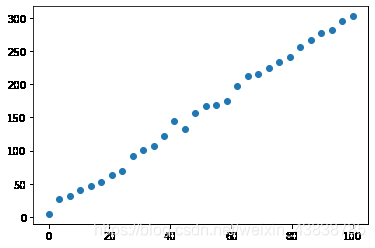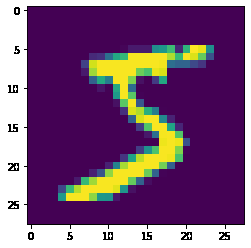前言
本文分为三部分:
a.线性回归
b.手写数字识别
c.手写数字识别模型优化。
1 线性回归预测
import keras
Using TensorFlow backend.
c:\program files\python36\lib\site-packages\tensorflow\python\framework\dtypes.py:519: FutureWarning: Passing (type, 1) or '1type' as a synonym of type is deprecated; in a future version of numpy, it will be understood as (type, (1,)) / '(1,)type'.
_np_qint8 = np.dtype([("qint8", np.int8, 1)])
c:\program files\python36\lib\site-packages\tensorflow\python\framework\dtypes.py:520: FutureWarning: Passing (type, 1) or '1type' as a synonym of type is deprecated; in a future version of numpy, it will be understood as (type, (1,)) / '(1,)type'.
_np_quint8 = np.dtype([("quint8", np.uint8, 1)])
c:\program files\python36\lib\site-packages\tensorflow\python\framework\dtypes.py:521: FutureWarning: Passing (type, 1) or '1type' as a synonym of type is deprecated; in a future version of numpy, it will be understood as (type, (1,)) / '(1,)type'.
_np_qint16 = np.dtype([("qint16", np.int16, 1)])
c:\program files\python36\lib\site-packages\tensorflow\python\framework\dtypes.py:522: FutureWarning: Passing (type, 1) or '1type' as a synonym of type is deprecated; in a future version of numpy, it will be understood as (type, (1,)) / '(1,)type'.
_np_quint16 = np.dtype([("quint16", np.uint16, 1)])
c:\program files\python36\lib\site-packages\tensorflow\python\framework\dtypes.py:523: FutureWarning: Passing (type, 1) or '1type' as a synonym of type is deprecated; in a future version of numpy, it will be understood as (type, (1,)) / '(1,)type'.
_np_qint32 = np.dtype([("qint32", np.int32, 1)])
c:\program files\python36\lib\site-packages\tensorflow\python\framework\dtypes.py:528: FutureWarning: Passing (type, 1) or '1type' as a synonym of type is deprecated; in a future version of numpy, it will be understood as (type, (1,)) / '(1,)type'.
np_resource = np.dtype([("resource", np.ubyte, 1)])
import numpy as np
import matplotlib.pyplot as plt
%matplotlib inline
x=np.linspace(0,100,30)
y=3*x+7+np.random.randn(30)*6
x
array([ 0. , 3.44827586, 6.89655172, 10.34482759,
13.79310345, 17.24137931, 20.68965517, 24.13793103,
27.5862069 , 31.03448276, 34.48275862, 37.93103448,
41.37931034, 44.82758621, 48.27586207, 51.72413793,
55.17241379, 58.62068966, 62.06896552, 65.51724138,
68.96551724, 72.4137931 , 75.86206897, 79.31034483,
82.75862069, 86.20689655, 89.65517241, 93.10344828,
96.55172414, 100. ])
y
array([ 4.51440317, 26.25914239, 31.31959183, 40.88305373,
47.23353782, 52.12131196, 63.47049378, 69.38831163,
91.34933604, 100.32051013, 106.63513579, 121.44319809,
143.85751839, 133.16091292, 157.33693677, 167.16364628,
169.22570758, 175.27839772, 196.90560814, 212.32010811,
215.80391853, 223.70326853, 233.37777019, 241.45304151,
255.68397824, 266.73365369, 276.66691758, 281.3290158 ,
295.98657774, 302.39809267])
plt.scatter(x,y)

y=ax+b
#建立模型
model=keras.Sequential() # 顺序模型
from keras import layers
#添加层 指定输入输出维度 初始化两个param(a,b) 之后训练ab
model.add(layers.Dense(1,input_dim=1))
model.summary()
_________________________________________________________________
Layer (type) Output Shape Param #
=================================================================
dense_1 (Dense) (None, 1) 2
=================================================================
Total params: 2
Trainable params: 2
Non-trainable params: 0
_________________________________________________________________
#编译模型 loss是什么 使用什么算法优化loss
model.compile(optimizer='adam',
loss='mse'
)
#训练模型
model.fit(x,y,epochs=3000)
Epoch 1/3000
30/30 [==============================] - 0s 13ms/step - loss: 13768.0615
..........................................................................
Epoch 2568/3000
30/30 [==============================] - 0s 67us/step - loss: 248.5746
plt.scatter(x,y,c='r')
plt.plot(x,model.predict(x))

model.predict([150])
array([[442.45358]], dtype=float32)
#442
2 手写数字识别
import keras
from keras import layers
import matplotlib.pyplot as plt
%matplotlib inline
Using TensorFlow backend.
c:\program files\python36\lib\site-packages\tensorflow\python\framework\dtypes.py:519: FutureWarning: Passing (type, 1) or '1type' as a synonym of type is deprecated; in a future version of numpy, it will be understood as (type, (1,)) / '(1,)type'.
_np_qint8 = np.dtype([("qint8", np.int8, 1)])
c:\program files\python36\lib\site-packages\tensorflow\python\framework\dtypes.py:520: FutureWarning: Passing (type, 1) or '1type' as a synonym of type is deprecated; in a future version of numpy, it will be understood as (type, (1,)) / '(1,)type'.
_np_quint8 = np.dtype([("quint8", np.uint8, 1)])
c:\program files\python36\lib\site-packages\tensorflow\python\framework\dtypes.py:521: FutureWarning: Passing (type, 1) or '1type' as a synonym of type is deprecated; in a future version of numpy, it will be understood as (type, (1,)) / '(1,)type'.
_np_qint16 = np.dtype([("qint16", np.int16, 1)])
c:\program files\python36\lib\site-packages\tensorflow\python\framework\dtypes.py:522: FutureWarning: Passing (type, 1) or '1type' as a synonym of type is deprecated; in a future version of numpy, it will be understood as (type, (1,)) / '(1,)type'.
_np_quint16 = np.dtype([("quint16", np.uint16, 1)])
c:\program files\python36\lib\site-packages\tensorflow\python\framework\dtypes.py:523: FutureWarning: Passing (type, 1) or '1type' as a synonym of type is deprecated; in a future version of numpy, it will be understood as (type, (1,)) / '(1,)type'.
_np_qint32 = np.dtype([("qint32", np.int32, 1)])
c:\program files\python36\lib\site-packages\tensorflow\python\framework\dtypes.py:528: FutureWarning: Passing (type, 1) or '1type' as a synonym of type is deprecated; in a future version of numpy, it will be understood as (type, (1,)) / '(1,)type'.
np_resource = np.dtype([("resource", np.ubyte, 1)])
import keras.datasets.mnist as minst
(train_image,train_label),(test_image,test_label)=minst.load_data()
train_image.shape
(60000, 28, 28)
plt.imshow(train_image[0])

train_label[0]
5
train_label
array([5, 0, 4, ..., 5, 6, 8], dtype=uint8)
test_image.shape
(10000, 28, 28)
model=keras.Sequential()
model.add(layers.Flatten(input_shape=[28,28])) #展平 (60000,28,28)-》(60000,28*28)
model.add(layers.Dense(64,activation='relu'))# 关注第二维度 输入28*28 全连接64个单元 再输出到10个单元
model.add(layers.Dense(10,activation='softmax'))# 多分类 使用softmax激活
model.compile(optimizer='adam',
loss='sparse_categorical_crossentropy',#交叉熵
metrics=['acc']
)
model.fit(train_image,train_label,epochs=50,batch_size=512)
Epoch 1/50
60000/60000 [==============================] - 1s 20us/step - loss: 8.0500 - acc: 0.4950
Epoch 50/50
60000/60000 [==============================] - 1s 11us/step - loss: 1.7518 - acc: 0.8901
<keras.callbacks.History at 0x199f81df908>
model.evaluate(test_image, test_label)#模型评价
10000/10000 [==============================] - 0s 45us/step
[1.8363827221155036, 0.8847]
model.evaluate(train_image, train_label)#该模型在训练集和测试集得分差别不大,得分都比较低,属于欠拟合
60000/60000 [==============================] - 2s 34us/step
[1.7373228628097839, 0.8907666666666667]
import numpy as np
np.argmax(model.predict(test_image[:10]), axis=1)#axis=1 在第一维,最后一维上
array([7, 2, 1, 0, 4, 1, 4, 9, 6, 9], dtype=int64)
test_label[:10]
array([7, 2, 1, 0, 4, 1, 4, 9, 5, 9], dtype=uint8)
#对比可得预测错误一个
3 模型优化
增大网络容量,直至过拟合
增加两个隐藏层
model = keras.Sequential()
model.add(layers.Flatten()) # (60000, 28, 28) ---> (60000, 28*28)
model.add(layers.Dense(64, activation='relu'))
model.add(layers.Dense(64, activation='relu'))
model.add(layers.Dense(64, activation='relu'))
model.add(layers.Dense(10, activation='softmax'))
model.compile(optimizer='adam',
loss='sparse_categorical_crossentropy',
metrics=['acc']
)
model.fit(train_image, train_label, epochs=50, batch_size=512, validation_data=(test_image, test_label))

训练集测试集正确率得分都很高
增大容量可以有效提高准确度
分析测试正确率和训练正确率,我们发现网络还是有一些过拟合,所以采用Dropout抑制过拟合
model = keras.Sequential()
model.add(layers.Flatten()) # (60000, 28, 28) ---> (60000, 28*28)
model.add(layers.Dense(64, activation='relu'))
model.add(layers.Dense(64, activation='relu'))
model.add(layers.Dropout(0.5))
model.add(layers.Dense(64, activation='relu'))
model.add(layers.Dropout(0.5))
model.add(layers.Dense(10, activation='softmax'))
增加Dropout层则训练模型时epoch增加些,让其多训练几次
model.compile(optimizer='adam',
loss='sparse_categorical_crossentropy',
metrics=['acc']
)
model.fit(train_image, train_label, epochs=200, batch_size=512, validation_data=(test_image, test_label))

分析数据,训练数据得分下降一些,限额是数据得分不变。抑制了过拟合。
